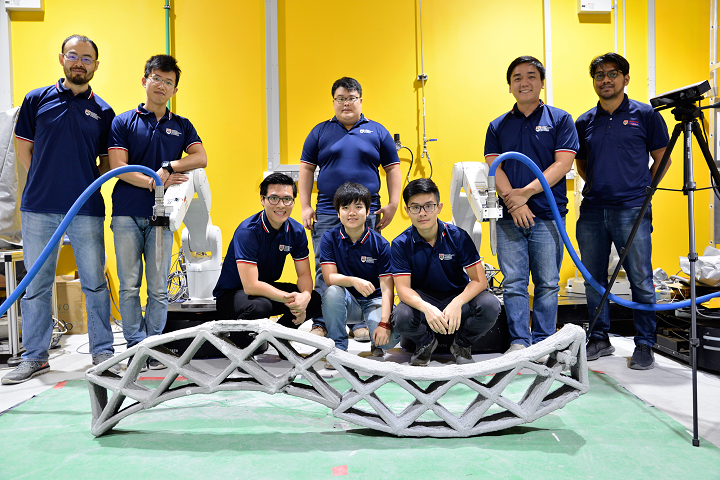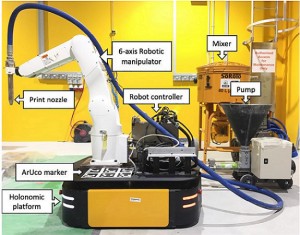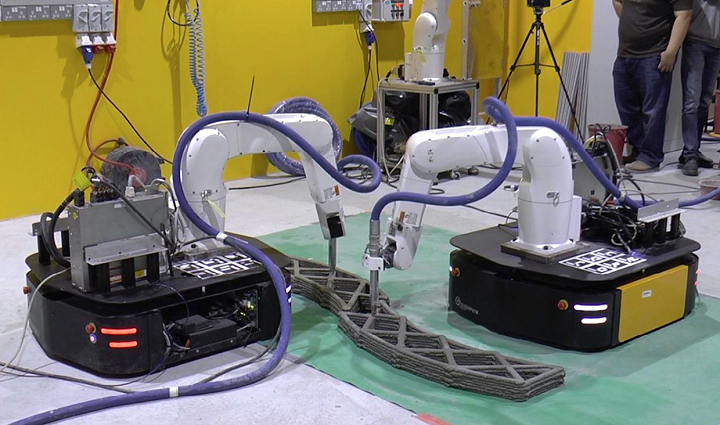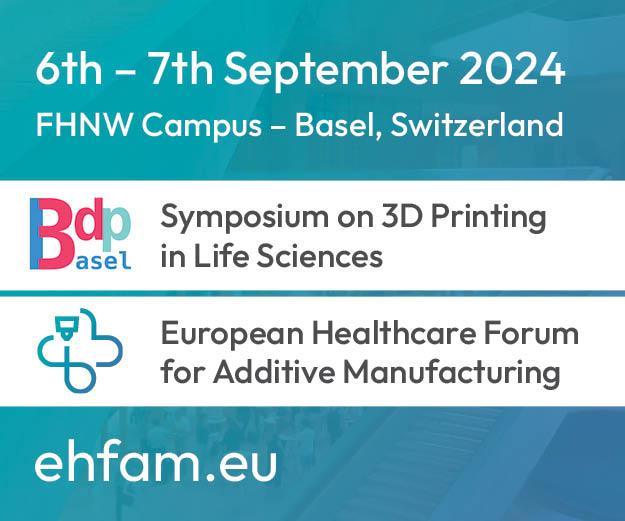
NTU Assistant Professor Pham Quang Cuong (3rd from left) with his multidisciplinary team of researchers consisting of roboticists, civil engineers, mechanical engineers and material scientists, with the concrete structure 3D printed by the two robots concurrently in a single print.
In August, a multidisciplinary team of researchers from Nanyang Technological University Singapore (NTU Singapore) published a paper in the Automation in Construction journal for civil engineering about their work in developing a smart robotic construction method, in which two robots work simultaneously to 3D print a concrete structure. Large-scale 3D printing of objects, like buildings, is possible, but volume constraints and length of time can still be issues…unless, of course, you enter mobile robots capable of synchronized concrete 3D printing into the equation.
The NTU Singapore Centre for 3D Printing (SC3DP) team developing the technology is led by Assistant Professor Pham Quang Cuong with NTU’s School of Mechanical and Aerospace Engineering, who also worked on a collaborative project this spring where two autonomous robotic arms put together an IKEA chair in less than 9 minutes.
NTU Assistant Professor Pham Quang Cuong (R) working with PhD student Ms Zhang Xu to develop faster, more efficient ways of 3D printing concrete structures.
Professor Pham explained, “We envisioned a team of robots which can be transported to a work site, print large pieces of concrete structures and then move on to the next project once the parts have been printed.
“This research builds on the knowledge we have acquired from developing a robot that can autonomously assemble an Ikea chair. But this latest project is more complex in terms of planning, execution, and on a much larger scale.”
The team’s method of concurrent, or swarm, 3D printing is laying the groundwork for mobile construction robot teams to 3D print even larger structures, like full buildings, in the future. At the moment, large-scale 3D printers that are bigger than the objects they’re building are required to make big concrete structures. As most construction sites have space constraints to deal with, this isn’t really a feasible method of manufacturing.
“Scalability is a problem common to most existing 3D printing processes, where the size of the design is strictly constrained by the chamber volume of the 3D printer. This issue is more pronounced in the building and construction industry, where it is impractical to have printers that are larger than actual buildings,” the abstract of the team’s paper explains.
But using several mobile robots to 3D print at the same time means that larger structures, such as special facades and architectural features, can be built anywhere, provided that the work site has enough room for the robots to move around. It will also be possible to produce structures on demand at a much faster rate of speed.
In just eight minutes, the NTU Singapore team’s robots were able to 3D print a concrete structure, using a specially formulated cement mix, that measured 1.86 x 0.46 x 0.13 m. It took two days for the structure to harden, and a week to achieve full strength before it was deemed ready for installation. The team’s 3D printable cement mix also makes it possible to create unique designs that could not be completed using traditional casting methods.
It’s obviously not easy to use two mobile robots to concurrently 3D print a concrete structure. Both robots need to move into position and begin printing without bumping into the other one. Additionally, it wasn’t feasible to print the structure in separate segments, since joints between parts wouldn’t properly bond if the material didn’t overlap during 3D printing.
 The team’s multi-step process begins with using a computer to map out the design and assign each robot a specific portion of 3D printing. Then, a special algorithm is used to make sure that the robots won’t collide during printing. For optimal consistency, the specialized liquid concrete mix has to be blended evenly, at the same time, during mixing and pumping.
The team’s multi-step process begins with using a computer to map out the design and assign each robot a specific portion of 3D printing. Then, a special algorithm is used to make sure that the robots won’t collide during printing. For optimal consistency, the specialized liquid concrete mix has to be blended evenly, at the same time, during mixing and pumping.
Once the material is ready, the robots then move into place with precise location positioning and begin 3D printing the parts, making sure the alignment is correct and the joints properly overlap.
When you combine disruptive Industry 4.0 technologies such as 3D printing with others like AI, robotics, materials science, and green manufacturing methods, it’s possible to advance all of them even further.
“This multiple robot printing project is highly interdisciplinary, requiring roboticists to work with materials scientists to make printable concrete. To achieve the end result of a strong concrete structure, we had to combine their expertise with mechanical engineers and civil engineering experts,” said Professor Chua Chee Kai, the Executive Director of the Singapore Centre for 3D Printing.
“Such an innovation demonstrates to the industry what is feasible now, and prove what is possible in the future if we are creative in developing new technologies to augment conventional building and construction methods.”
The NTU Singapore team will now be focusing on integrating more robots to 3D print larger structures, in addition to improving the concrete material to ensure faster curing and further optimizing their 3D printing algorithm for consistent performance. The National Research Foundation, Singapore (NRF Singapore) and Sembcorp Design and Construction, an important industry research partner of SC3DP, are supporting the project.
Discuss this story and other 3D printing topics at 3DPrintBoard.com or share your thoughts in the Facebook comments below.
[Images: NTU Singapore]Subscribe to Our Email Newsletter
Stay up-to-date on all the latest news from the 3D printing industry and receive information and offers from third party vendors.
You May Also Like
Governor of Michigan & Secretary of the Navy Announce Michigan Maritime Manufacturing Initiative
The US Navy is once again demonstrating that it’s at the forefront of the domestic advanced manufacturing landscape, with Secretary of the Navy Carlos Del Toro on July 22 announcing...
The Public Arena: EOS Government Relations Manager on Why the Company is All in on Reshoring 3D Printing
EOS has never not been at the forefront of additive manufacturing (AM). Among countless other feats, the German company, which has a strong presence in the US, has a global...
3D Printing Service with a Smile: Protolabs CEO Rob Bodor on the Company’s Future in AM
Protolabs (NYSE: PRLB) is much more than a 3D printing company, it’s a comprehensive digital manufacturer. Nevertheless, precisely because the company has competencies in more or less every cutting-edge industrial...
Siemens Increases Attention on US 3D Printing Landscape
Global industrial giant Siemens has announced that the company is taking steps to help bolster the US additive manufacturing (AM) industry. The efforts will surround Siemens’ Charlotte Advanced Technology Collaboration...



































